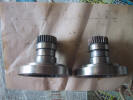
On the right is the oil driven gear hub with worn
splines. The splines are what mate to the wheel hub splines. A new
unit is on the left. |
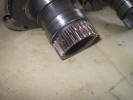
Worn splines... |
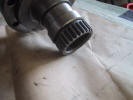
...new splines. |
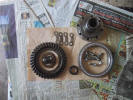
All the new parts needed for assembly. Driven gear
hub, half moon lock washers, ring gear, shims, spacer, 22X40X10
seal, #1000822 (110X140X16)bearing and 8 M12 X 1.25 bolts. |

Place the #1000822 bearing on a hard surface and set
the driven gear hub atop it. |

Use a hard block of wood and hammer to gently tap in
a cross pattern 9 o'clock... |

...3 o'clock... |
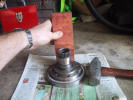
...12 o'clock... |

...6 o'clock. Whilst doing this keep the hub as level
as possible. |
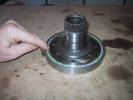
Seat the hub level to the shoulder of the bearing
as the ring gear must sit on top the two pieces. |
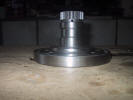
Side view of driven gear hub seated in bearing. |
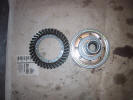
Take the ring gear and place it on top of the hub
assembly. Take care in aligning the bolt holes. A couple of
light raps on the floor should be enough to seat it. |
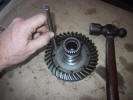
If needed, a couple light blows with a tommy bar
and hammer will finish setting the ring gear. |
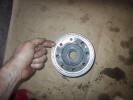
When turned over, the driven gear hub should be
slightly recessed into the bearing. This is so the half moon
washers and bolts will not come into contact with the shift
coupling gear in the outer case. |

The half moon lock washers fit like so... |

It is easier to pre bend the ends of the washers
in a vise. Bend them up approximately 45 degrees. |
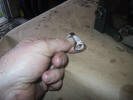
Bend the top side which is facing outward on the
hub assembly. |

Using a ratchet and 12mm socket, install the 8
bolts. |
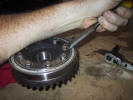
Use a wood chisel or similar tool and a hammer to
bend the half moon washer tabs up on the bolt flats.
|

Use a tommy bar and hammer if needed to finish
the job. Sorry about the camera leash... |

On the left is the original spacer. You can see
when compared to the new one on the right that the ends are worn
away. Time to replace it. |
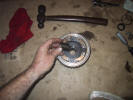
Turn the hub assembly over and drop the spacer
inside the axle channel. |
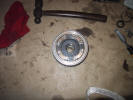
Spacer is in and the 22X40X10 seal is ready to
install. |
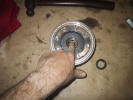
The seal needs to press down to this lip inside
the channel. |
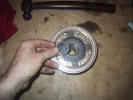
The seal goes in face down. You should be looking
at the side of the seal with the tension spring. |

It is very easy to damage the seal when seating
one "upside down". I used a 15/16" socket with an extension
going through the socket so the base of
the socket was in contact with the seal. |

Carefully align the seal in the hub channel. No
cocking is permitted or you will damage the seal. Slowly tap the
seal down, removing the socket and checking progress every few
taps. |
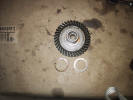
Once the seal is in place turn the driven gear
hub over. All that is left is to install the bronze and steel
spacers on the shaft. |
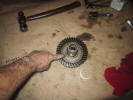
The bronze spacer goes on first. There is only
one thickness of this spacer. |
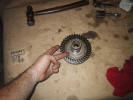
The steel spacer goes on second (hence the two
fingers). There are 4 thicknesses of this spacer; 1.1mm, .95mm,
.8mm and .65mm. These in conjunction with the final case gaskets
are used to set the gear lash between the ring and pinion gears.
This will be discussed further in 7.9(i) below. |